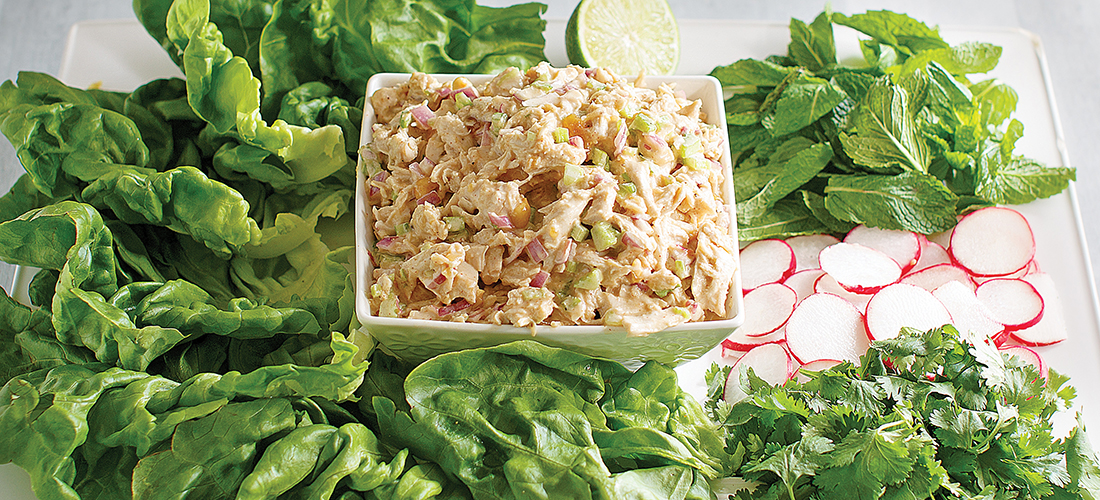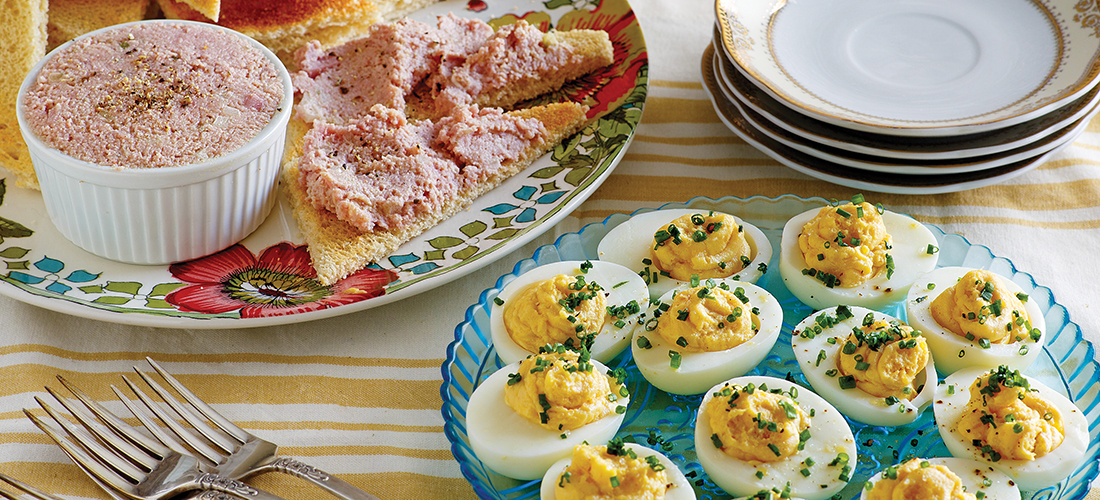Food for Thought
(Chicken) Salad Days
There is nothing like chicken salad. Whether homey or haute, it can be the centerpiece of any summer meal
By Jane Lear
Aside from the “fiesta” or “Oriental” versions found at some chain restaurants, chicken salad has pretty much been relegated to the Nostalgia Department: suitable fare for tearooms, drugstore lunch counters and Southern porch suppers, circa 1955.
I don’t know why. I suppose people are afraid of the fat in mayonnaise — common to most recipes — or perhaps the technique of poaching chicken — ditto — sounds difficult. This should change. Chicken salad should become a trend.
I mean, if I had a restaurant — a little roadside café, say — I’d feature a chicken salad sandwich of the week. Or perhaps I’d serve nothing but chicken salad; if one of the whiz kids behind the grilled-cheese-shop fad wants to diversify, we should talk.
No matter what, though, I always keep chicken salad in my regular rotation at home, because it’s a great make-ahead family supper or, fancied up with tarragon and toasted walnuts, for instance, or with a curry dressing, a fabulous company meal.
In a perfect world, obviously, I’d always take the time to gently poach chicken breast halves, complete with bones and skin: Not only is that one key to flavorful yet clean-tasting meat (along with using a wholesome pastured bird), but the light broth is handy for moistening the salad (instead of more mayo) if it starts to dry out — a trick I learned back in my years at Gourmet.
Life has a tendency to get in the way, however, and I’m here to remind you that you can make delicious chicken salad from leftover sautéed or roasted chicken, or even a store-bought rotisserie bird.
For sheer speed and efficiency, it’s hard to beat that last option, so I’m always a little shocked when I meet people who are snooty about rotisserie, or spit-roasted, chickens, one of the greatest convenience foods on the planet. Have they ever been to an outdoor market in France? I wonder. The queue for poulet rôti should be a tip-off that it’s an honest, worthy substitute for a home-roasted chicken in many a French kitchen.
And in mine, too. I’ll often buy two on the way home in the evening — one for eating that night, with some harissa-slicked couscous and quick-cooked greens, for example — and the other for salad, later in the week. While it’s still warm, I’ll strip it of bones and skin, shred both white and dark meat, and combine it with the dressing. Honestly, anyone can do this.
As far as chicken salad recipes go, I like having a repertoire. Several old-school renditions are embellished with toasted slivered almonds and grapes, cut in half lengthwise. A famous one, which is rich and light all at the same time (aside from red grapes, almonds, celery and parsley, the recipe includes unsweetened whipped cream), was created by renowned Texas cook Helen Corbitt for the café menu at the Neiman Marcus department store in the ’50s. We also have Corbitt to thank for Texas caviar (i.e., pickled black-eyed peas) and poppy-seed dressing.
Other chicken salads in this genre rely on a one-to-one ratio of mayonnaise and sour cream, and green grapes instead of red. In general, this sort of chicken salad is utterly predictable and absolutely delicious. You’ll want to serve it on a bed of soft-leaf lettuces, and on your mother’s china. A side of steamed asparagus and maybe some Parker House rolls and good butter would make everyone very happy.
Lately, though, I’ve been relying on supermarket staples — in particular, Major Grey’s mango chutney and dry-roasted nuts — as well as a picked-up-on-the-run rotisserie bird to put a chicken salad supper on the table fast. What takes this combination out of the Coronation Chicken Salad realm (first made for Queen Elizabeth II’s coronation lunch in 1953, it’s been popular in Britain ever since) are the additions of cilantro, basil, mint, and lime juice for freshness and verve, as well as large, voluptuous leaves of butterhead lettuce, for making Southeast Asian-style roll-ups.
Fast-Track Chicken Salad with Mango Chutney and Cashews
1 medium red onion, chopped
1 jar Major Grey’s-style mango chutney (8 to 9 ounces), mango cut into smaller, bite-size pieces if too chunky
½1/2 cup mayonnaise (I’m a lifelong fan of Duke’s)
Fresh lime juice, to taste
Coarse salt and freshly ground pepper
1 rotisserie chicken (about 3 pounds), skin and bones discarded and meat shredded
2 to 3 celery stalks, chopped
Dry-roasted whole cashews or peanuts, coarsely chopped, to taste
For the roll-ups
1 or 2 butterhead lettuces such as Bibb, leaves separated, left whole, washed, and spun dry
Handfuls of fresh cilantro, basil and mint sprigs, rinsed and dried
Sliced radishes and/or seedless cucumber, optional
1. Stir together the onion, chutney, mayo and lime juice in a large bowl and season with salt and pepper. (Go easy on the salt if you’re going to be adding salted nuts.) Gently stir in the chicken until thoroughly combined. Give the flavors a chance to mingle for 20 or 30 minutes.
2. Just before serving, gently stir in the celery and nuts. Spoon the chicken salad onto a platter and arrange the roll-up fixings (lettuce leaves, herbs, and vegetables) around it so everyone can serve themselves. Your mother’s china, optional. OH
Jane Lear, formerly of Gourmet magazine and Martha Stewart Living, is the editor of Feed Me, a quarterly magazine for Long Island food lovers.


